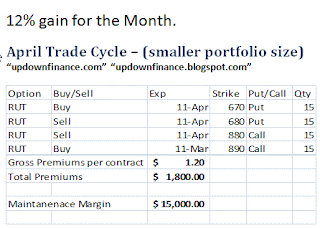The art of order execution is a vital part of trading and our Income Trading strategy. When we issue alerts, we normally give the range of prices within which the trade should be executed. Most subscribers basically put in their order at the high end of the range and wait, hoping it will be executed at that price. However, most of the time, prices are in of themselves dynamic and the art of order executing is also dynamic in nature. Pay attention to how the underling instrument is trading - its price and volatility - and watch the various market indexes. Then strategically adjust your order accordingly, with the goal of getting filled at the best price possible without chasing the trade. Sometimes, there may be a temporary spike in prices either up or down, and you might be able to get your order filled at the high or top end of the range. But for the most part, given normal market conditions, you might have to engage the market makers and/or computer trading algorithms to get your order executed.
As a typical trade, we send out an alert and give a range of $1.40 to $1.60, for a total four leg Iron Condor Trade. When the alert is sent out, the trade is typically being quoted at the high end, $1.60 in this example. (This is a credit, so it is easier to get the trade executed when your price is at the lower end.) If you put in an order within the range $1.40 or $1.45, it will most likely get executed. Alternatively, you could start slightly below $1.60, e.g. at $1.55, and gradually negotiate and adjust your order to get it executed, as you monitor the variables mentioned above (price of the underlining instrument, volatility and the market indexes). They key is to get executed at the best possible price without missing out on the trade or chasing the trade and getting a bad execution.
For the most part, when we send out our alert, the low end of the trade is still good, and it’s okay to go a bit lower. For most of our income trades, we are trying to take in an average of $1.20 monthly.
The other issue is whether the Iron Condor trade should be executed as one single order, or executed separately as two credit spreads. Our rule of thumb, is try to get the order executed as a single trade, unless you are an experienced trader and understand the risks inherent in executing the trade as two separate credit spreads. A single order is best because otherwise one leg of the credit spread may be executed while the other leg gets away. If you chase the leg that gets away, this results in a skewed distribution of the credit received for the trade. If it gets away and you don’t chase it, you’ll end up with just one leg of the trade (i.e. a Put Credit Spread or a Call credit Spread). A typical example of a skewed trade is where we are trying to take in an average $1.20 worth of premiums but the two credit spreads are executed separately resulting in a premium $1.00 on the Call Spread and $0.20 on the Put Spread or vice-versa. Normally we want the amounts taken in on both spreads to be more similar. While we recommend executing the Iron Condor as a single trade, experienced traders may get the order executed separately and get filled at the top or better. But there are no guarantees!
So, next time we send out an alert, be strategic, opportunistic and most of all, get your order executed without chasing it. Remember the goal is to take in an average of $1.20 in premiums monthly.

